.
As a marketer, you might ponder generative AI’s role in the industry and the outlook for marketing jobs.
As a demand-gen marketer or a marketer to marketers, you may reflect on how you made it through a difficult year.
As a writer or manager of a corporate blog, you might review your current operations.
No matter your role, you may look for ways to strengthen your content and marketing in 2025.
Get help to improve your strategy in the coming year with these curated statistics from CMI’s 2024 research and bonus stats from the blogging survey by Andy Crestodina and Orbit Media Studios.
Content and marketing employment and career stats for 2025
CMI’s 2025 Career Outlook: Content and Marketing Professionals research (registration required) studied employment trends, job satisfaction, salaries, use of generative AI tools, and training/professional development.
Outlook for marketing jobs
- One in three marketers (33%) say their company laid off marketing employees in the last 12 months.
- Sixty-eight percent say finding a job in marketing is more challenging today than it was five years ago, 25% say it’s about the same, and 7% say it’s less challenging.
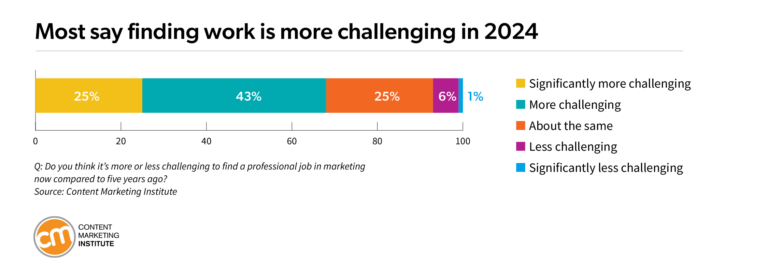
- Three-fourths of marketers list macroeconomic factors as a reason for the challenging job search environment, while 69% cite heightened competition. Only 33% indicate that AI is a factor.
Salary satisfaction and supplementary freelance income
- Marketers believe they should earn approximately 20% more than they currently do.
- More than one in five full-time marketers (22%) say they freelance on the side. On average, they make an additional $8,250 per year from these gigs.
Job satisfaction and plans for change
- Seventy-six percent of marketers say they’re somewhat or very satisfied in their roles.
- Those with roles at the director level and above are most likely to be very satisfied (79%). Forty percent are somewhat satisfied, 10% are neutral, and 12% are either somewhat or very dissatisfied.
- Even satisfied marketers keep their options open: 35% of all marketers say they’re pursuing or highly interested in finding another job (up 4 percentage points from the previous year and 7 percentage points from two years ago).
Remote work preferences
- Eighty-four percent of marketers work remotely, at least part-time.
- Among marketers who work remotely or in hybrid arrangements, 68% say they would leave their current employer if forced to work in the office full-time.
- A much higher percentage of women than men (55% vs. 35%) say they’d leave their current employer if forced to work in an office every day.
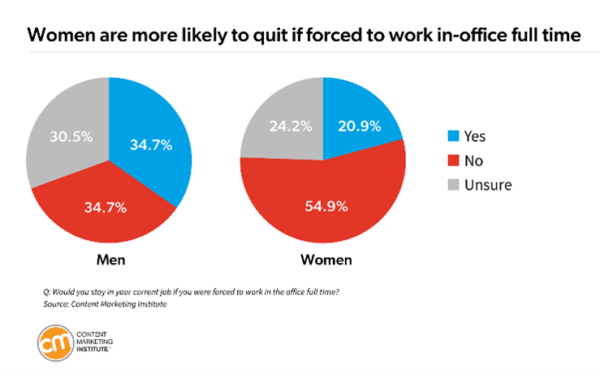
How content and marketing practitioners use AI
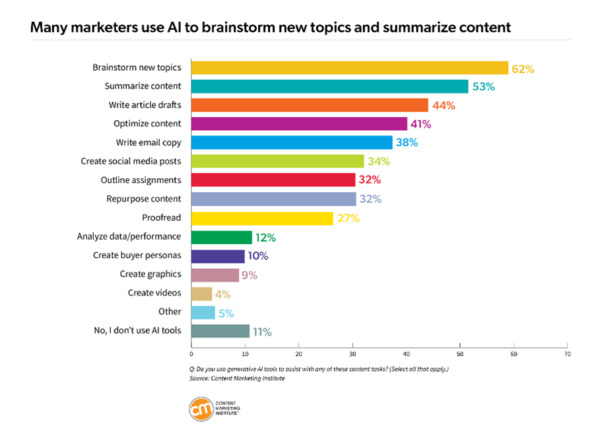
- Here’s the breakdown of their AI use:
- Brainstorm new topics (62%)Summarize content (53%)Write drafts (44%)Optimize content (41%)Write email copy (38%)Create social media posts (34%)Outline assignments (32%)Repurpose content (32%)Proofread (27%)Analyze data/performance (12%)Create buyer personas (10%)Create graphics (9%)Create videos (4%)
- Other (5%)
Eleven percent say they do not use AI tools.
Skills training offered and desired
- Only 35.5% say yes, their marketing training (internal and external) meets their career needs, while 29.7% say no, and 34.8% are unsure.
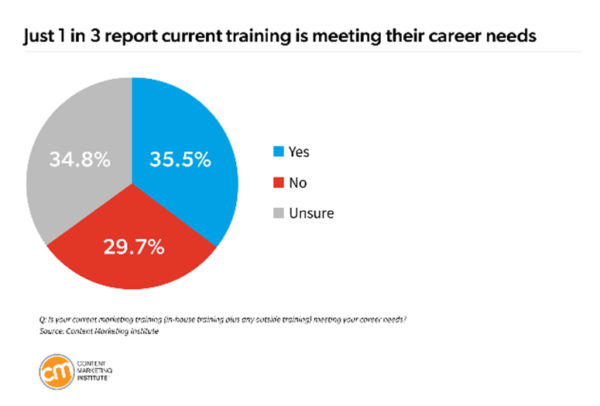
- Yet 76% of marketers say they need to master specialized or niche skills to remain relevant in the face of AI.
- And 58% of marketers say their organization’s training program is not keeping pace with changes in marketing.
- Forty-eight percent of marketers pursue professional training outside their organization.
Career guidance
If you suspect you’re underpaid, start by researching what others in your position make, as Ann Gynn advises in How To Make the Case for a Raise in Your Content or Marketing Role.
And don’t discount the value of a strong personal brand during this process.

Senior Marketing Strategist
JPMorgan Chase & Co.
We asked Bria Bell, senior marketing strategist at JPMorgan Chase & Co., for her thoughts on how content professionals and marketers can best position themselves for career growth:
“A strong personal brand can be a game-changer, whether you’re seeking a new opportunity or negotiating a raise. It’s about positioning yourself as an asset, demonstrating your unique value proposition, and building credibility.
“By highlighting your value and contributions, you can effectively advocate for a higher salary or better benefits.
“Additionally, enhancing your personal brand can boost your confidence, empowering you to quiet your inner critic and overcome imposter syndrome, thus allowing you to negotiate the terms you believe you deserve.”
What to do for your team
As noted, three in four marketers say they need to master specialized or niche skills to remain relevant. To keep your talent (and keep them happy and productive), look for opportunities to support them — either through internal or external training opportunities.
Regarding salaries, U.S. employers, on average, anticipate a 3.9% salary increase for 2025, about the same as actual growth in 2024, according to a new report from The Conference Board.
If you can’t afford an adequate raise, think about what else you can do to recognize and reward employees. Consider options like additional days off, participation in high-profile projects, or a change in title.
B2B content marketing statistics for 2025
CMI’s annual B2B Content Marketing Benchmarks, Budgets, and Trends: Outlook for 2025 research delved into the challenges faced by B2B marketers and how the top performers stand out.
Content marketing challenges
- Only 29% of marketers whose organizations have a documented content strategy say it’s extremely or very effective. Another 58% say it’s moderately effective, 12% say it’s not very effective, and 1% say it’s not at all effective.
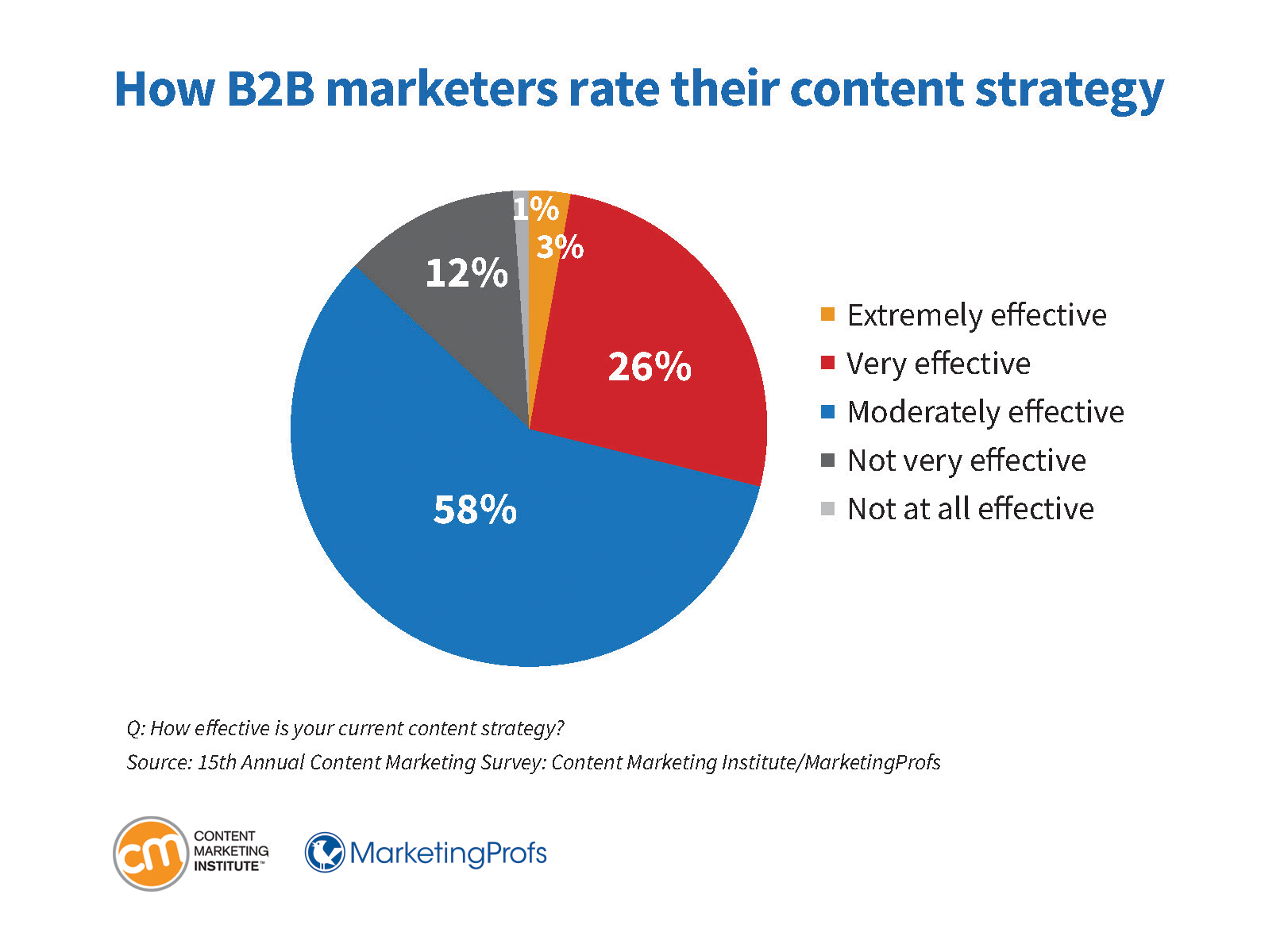
- Among B2B marketers who rate their strategy as moderately effective or worse, 42% attribute that in part to a lack of clear goals.
- Other reasons for less effective strategies include:
- Not tied to customer journey (39%)
- Not data driven (35%)
- Ineffective audience research (29%)
- Other (26%)
- Unrealistic expectations (23%)
- Emphasizes content quantity over quality (20%)
- Failure to iterate/adapt (18%)
- Inconsistent brand voice (17%)
- Poor content quality (10%)
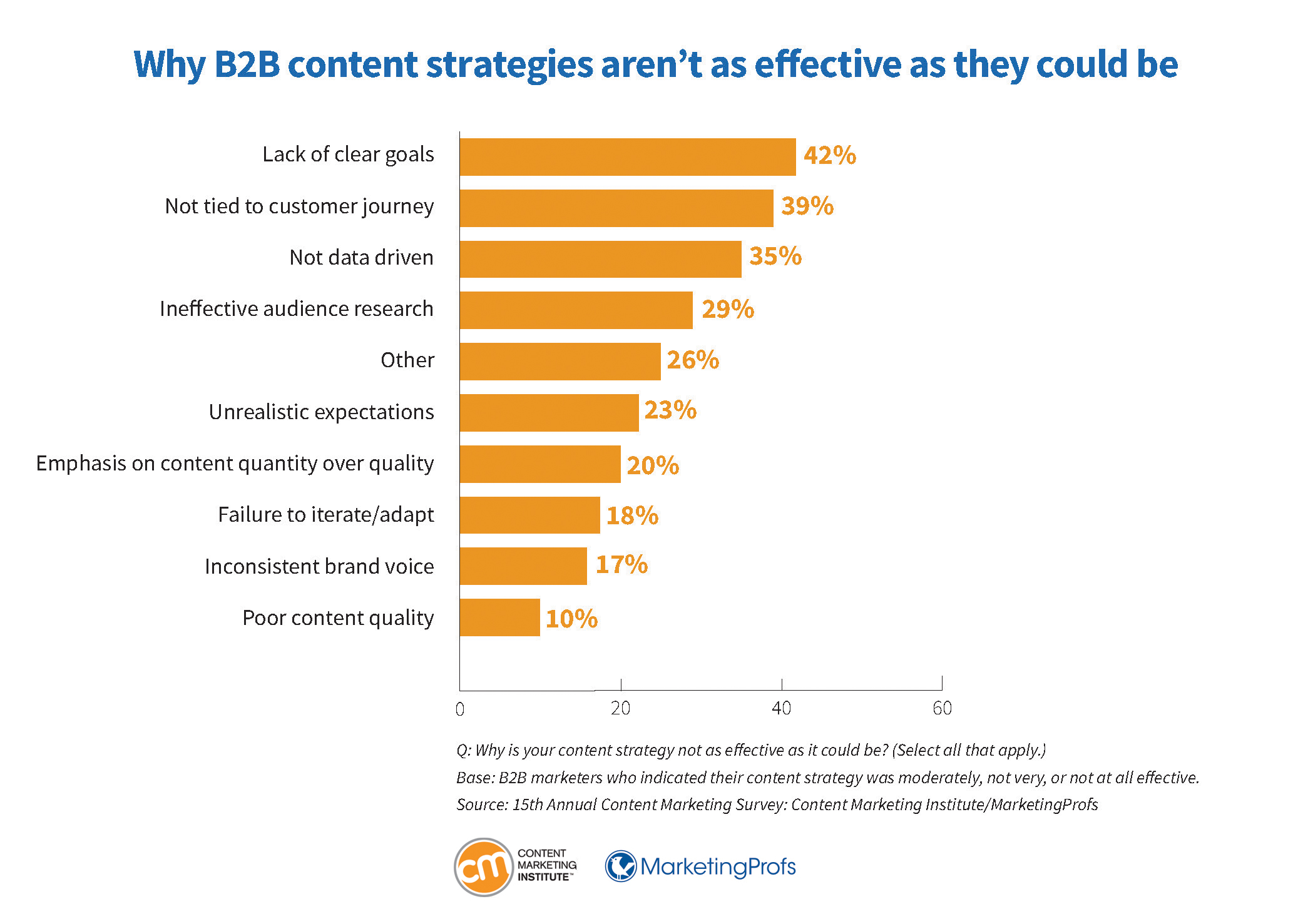
- Fifty-four percent of B2B marketers say lack of resources is a challenge.
- Forty-five percent of B2B marketers lack a scalable model for content creation. Thirty-five percent have one, and 20% are unsure.
- More than half of B2B marketers (55%) say it’s challenging to create content that prompts a desired action (e.g., conversions). Other content creation challenges include:
- Creating content consistently (42%)
- Creating the right content for our audience (40%)
- Creating enough content (39%)
- Optimizing for SEO (35%)
- Creating quality content (27%)
- Other (5%)
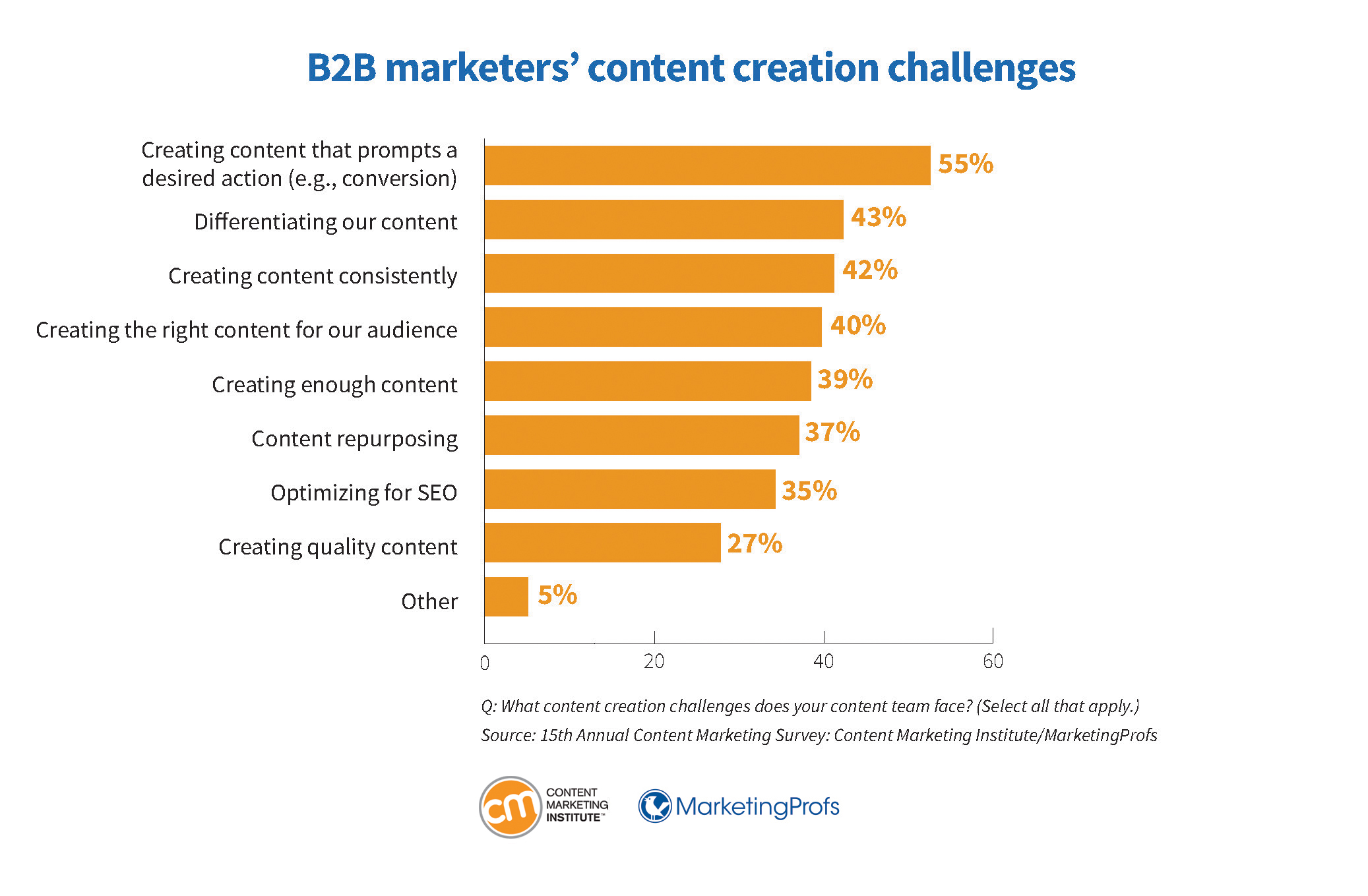
Technology issues
- When asked what’s missing from their marketing tech stack, 47% of B2B marketers say efficient lead generation and nurturing processes, and 47% say streamlined marketing data management and reporting. Other missing capabilities include:
- Ability to automate repetitive tasks and workflows (44%)
- Easy access to enterprise analytics (41%)
- Strong alignment between sales and marketing (39%)
Eight percent say their tech stack isn’t missing any capability.
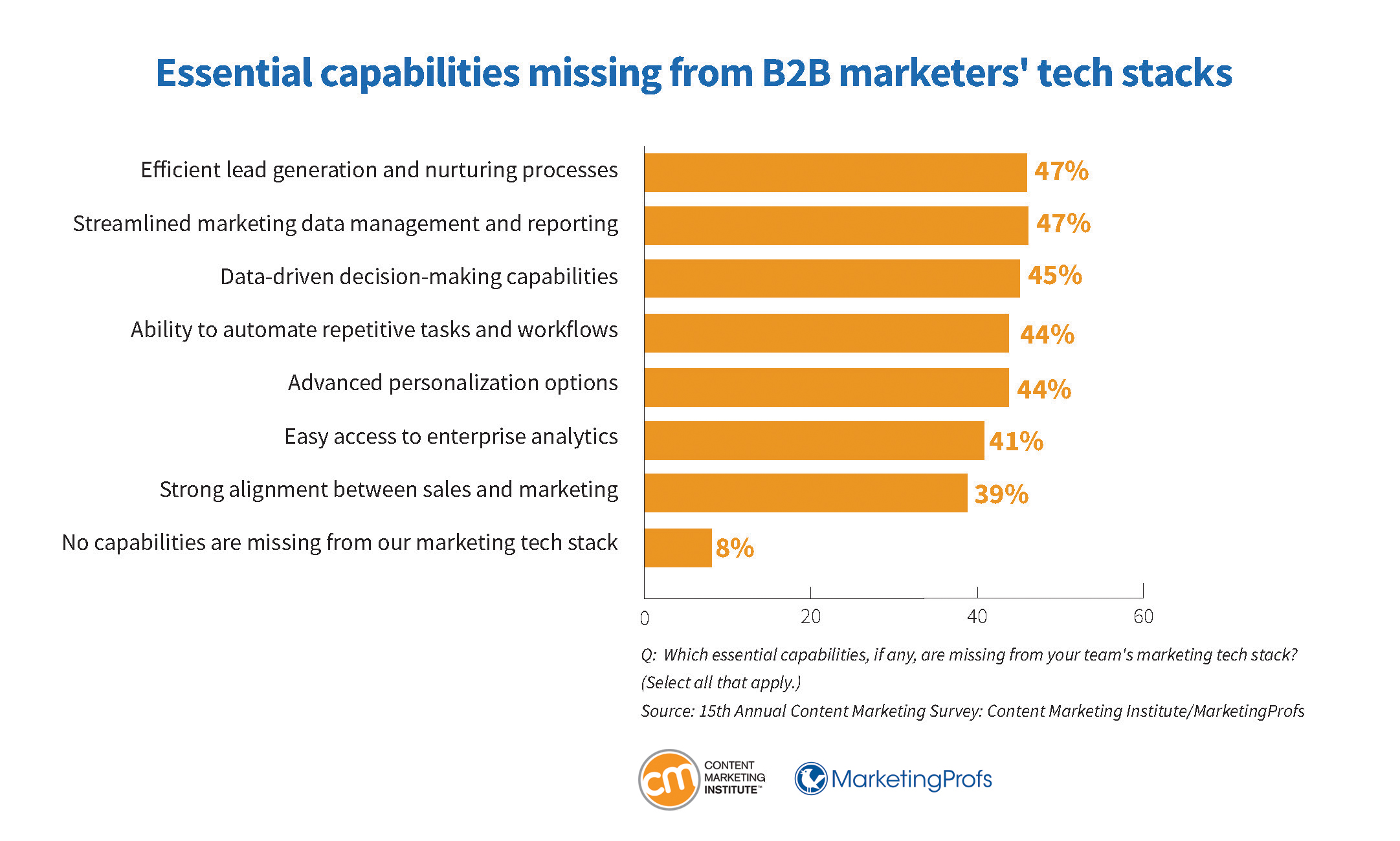
- Only 26% of B2B marketers say their organization has the right technology to manage content across the organization. Thirty-eight percent say they have the technology but aren’t using it to its potential. Twenty-seven percent say they haven’t acquired the right technology, and 9% are unsure.
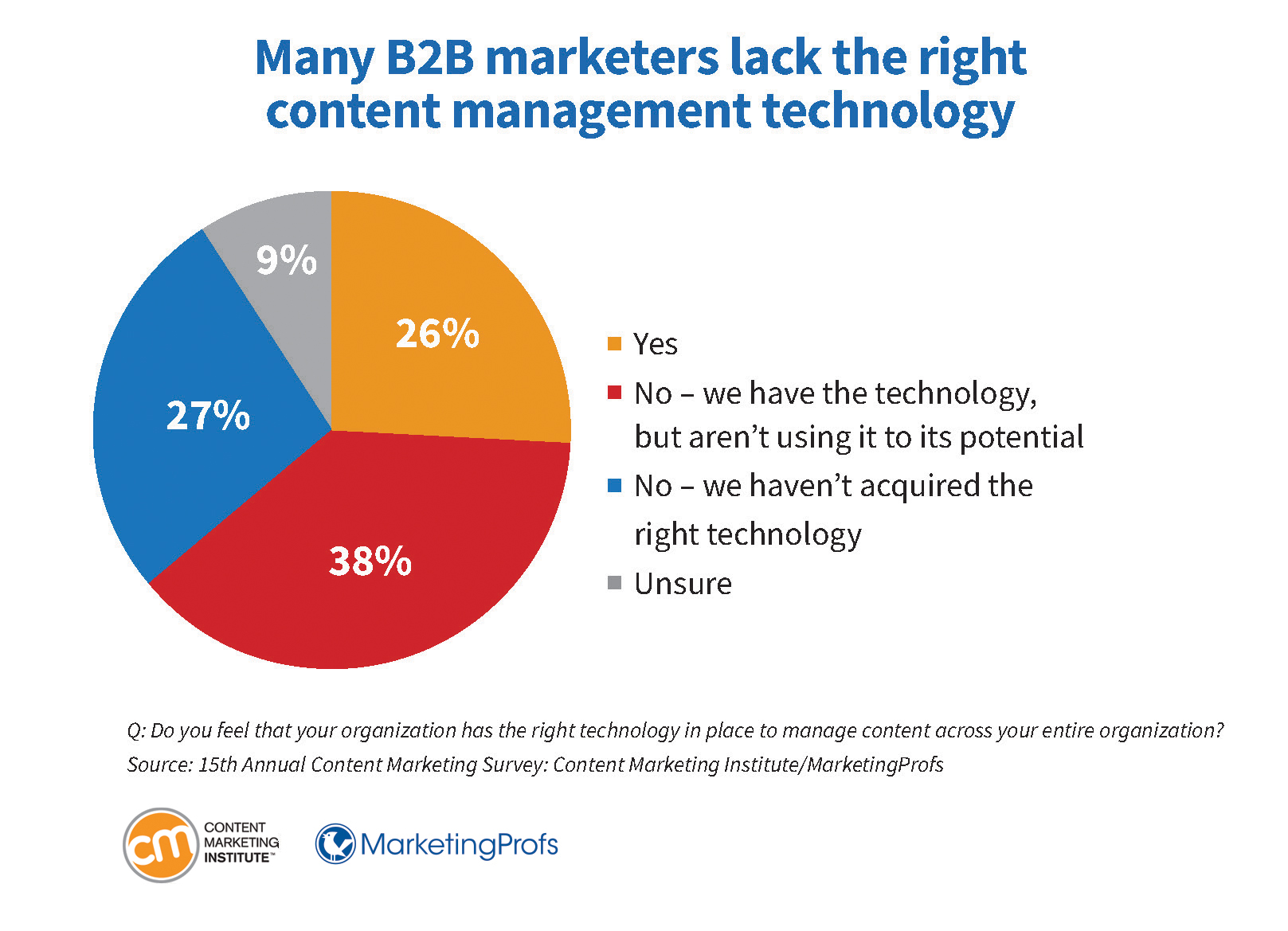
Metrics and goals
- The two challenges cited most often for B2B marketers measuring content performance are attributing ROI to content efforts (56%) and tracking customer journeys (56%).
- Eighty-seven percent of B2B marketers say content marketing created brand awareness in the last 12 months. Among the other content marketing achievements:
- Generated demand/leads (74%)
- Nurtured subscribers/audience/leads (62%)
- Grew loyalty with existing clients/customers (52%)
- Generated sales/revenue (49%)
- Grew a subscribed audience (37%)
- Reduced customer support costs (9%)
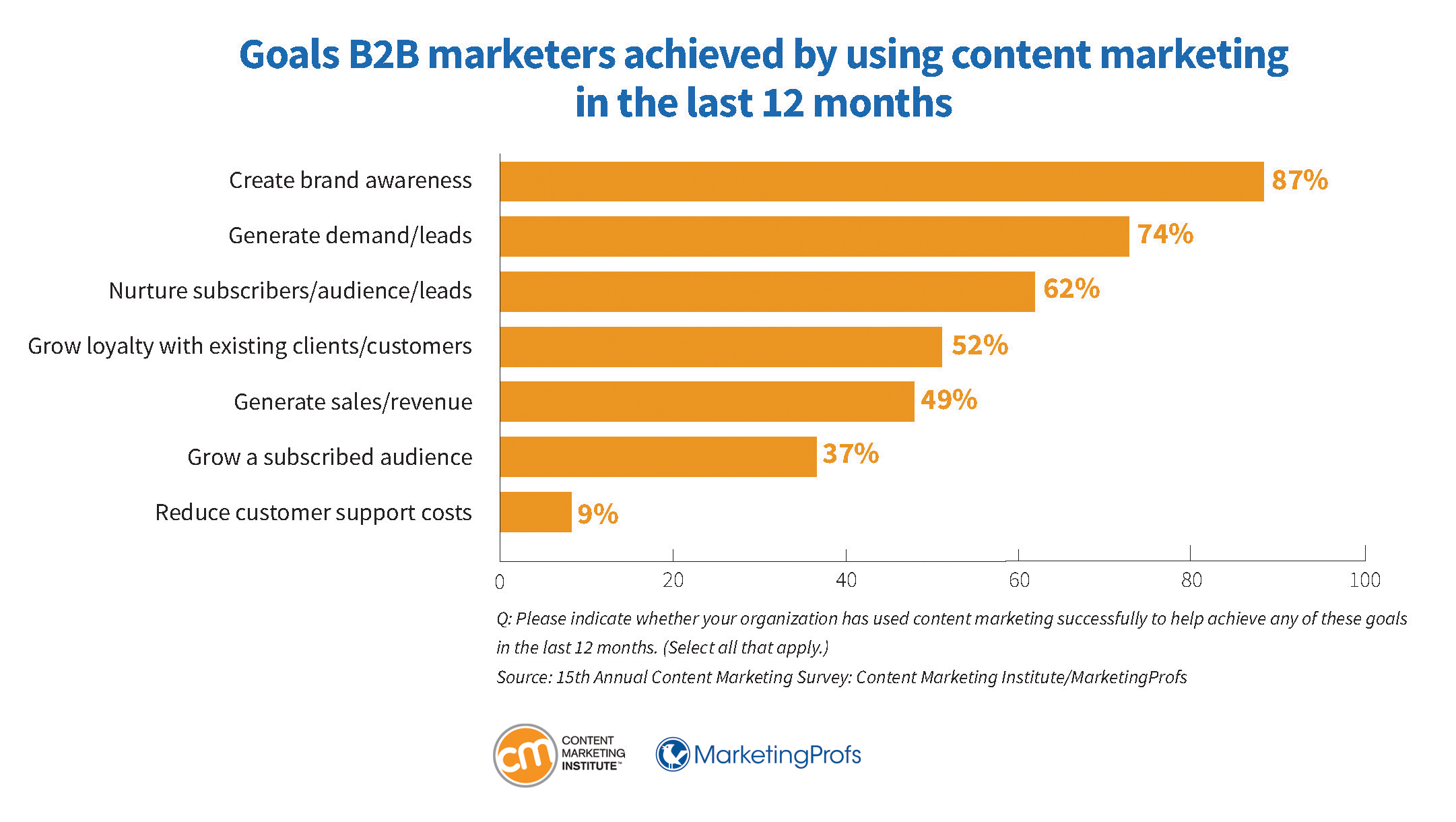
Top performer attributes and activities
- Twenty-two percent of B2B marketers characterize the success of their content marketing as extremely or very successful. These top performers most often attributetheir success to understanding their audience (82%). Other factors include:
- Produce high-quality content (77%)
- Possess industry expertise (70%)
- Have high-performing team members (69%)
- Set goals that align with their organization’s objectives (62%)
- Measure and demonstrate content performance effectively (53%)
- Have a documented strategy (47%)
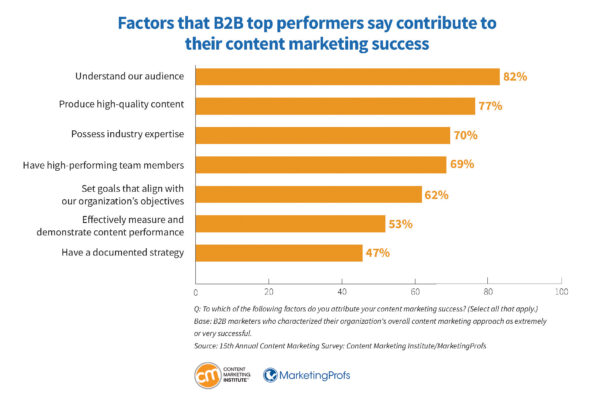
The characteristics among the most successful (top performers), the least successful, and all respondents break down as follows:
- Think the size of their content marketing team will grow in 2025: most successful (38%), least (19%), and all (27%)
- Say their content marketing strategy is extremely or very effective: most (74%), least (2%), and all (29%)
- Organization has generative AI usage guidelines: most (49%), least (29%), all (38%)
- AI is integrated into daily processes/workflows: most (31%), least (12%), and all (19%)
- Realizing more efficient workflows from AI: most (56%), least (31%), and all (45%)
- Seeing improved content optimization from AI: most (55%), least (31%), and all (42%)
- Have the right technology in place to manage content across the organization: most (46%), least (13%), and all (26%)
- Have a scalable model for content creation: most (61%), least (17%), and all (35%)
- Content creation model creates the desired outcomes: most (71%), least (6%), and all (41%)
- Agree that the organization measures content performance effectively: most (84%), least (15%), and all (51%)
In addition, performance level also produces differing results, including:
- Generate demand/leads: most successful (89%), least (49%), and all (74%)
- Nurture subscribers/audiences/leads: most (77%), least (36%), and all (62%)
- Grow loyalty with existing clients/customers: most (66%), least (33%), and all (52%)
- Generate sales/revenue: most (66%), least (33%), and all (52%)
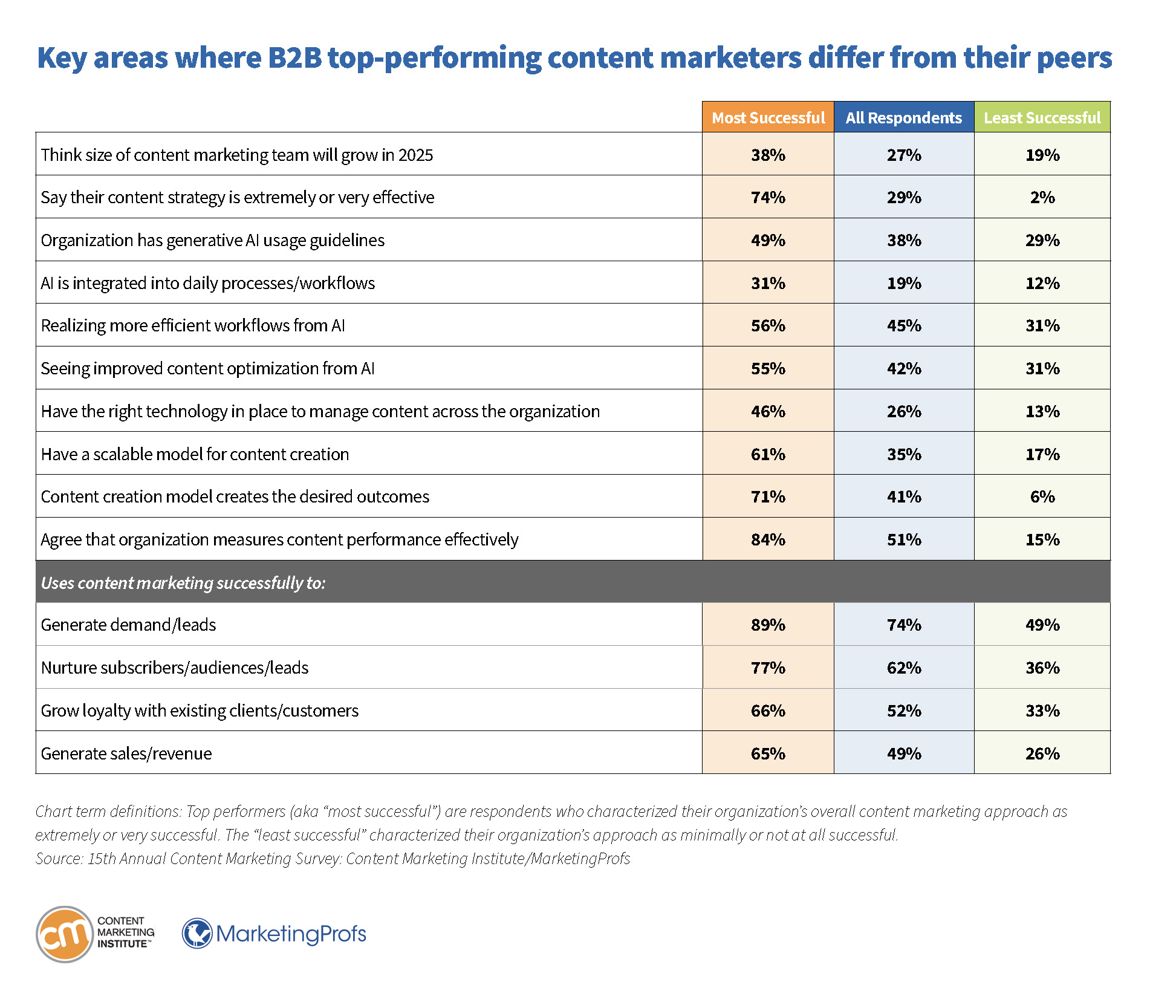
B2B marketers and AI
- Most B2B marketing teams (54%) take an ad hoc approach to AI (i.e., they’re experimenting but not necessarily applying it widely). Another 27% report that their teams don’t formally use AI, but individual staff members may choose to use it. Only 19% of B2B marketers say AI is integrated into their daily processes/workflows.
- Only 4% of B2B marketers report a high level of trust in generative AI’s outputs. Sixty-seven percent say they have a medium level of trust, and 28% say they have a low level of trust. Only 1% say they don’t trust AI’s output.
- Seventeen percent of B2B marketers rate the quality of the content generated by AI as excellent or very good. Forty-four percent say it’s good, 35% say it’s fair, and 4% say it’s poor.
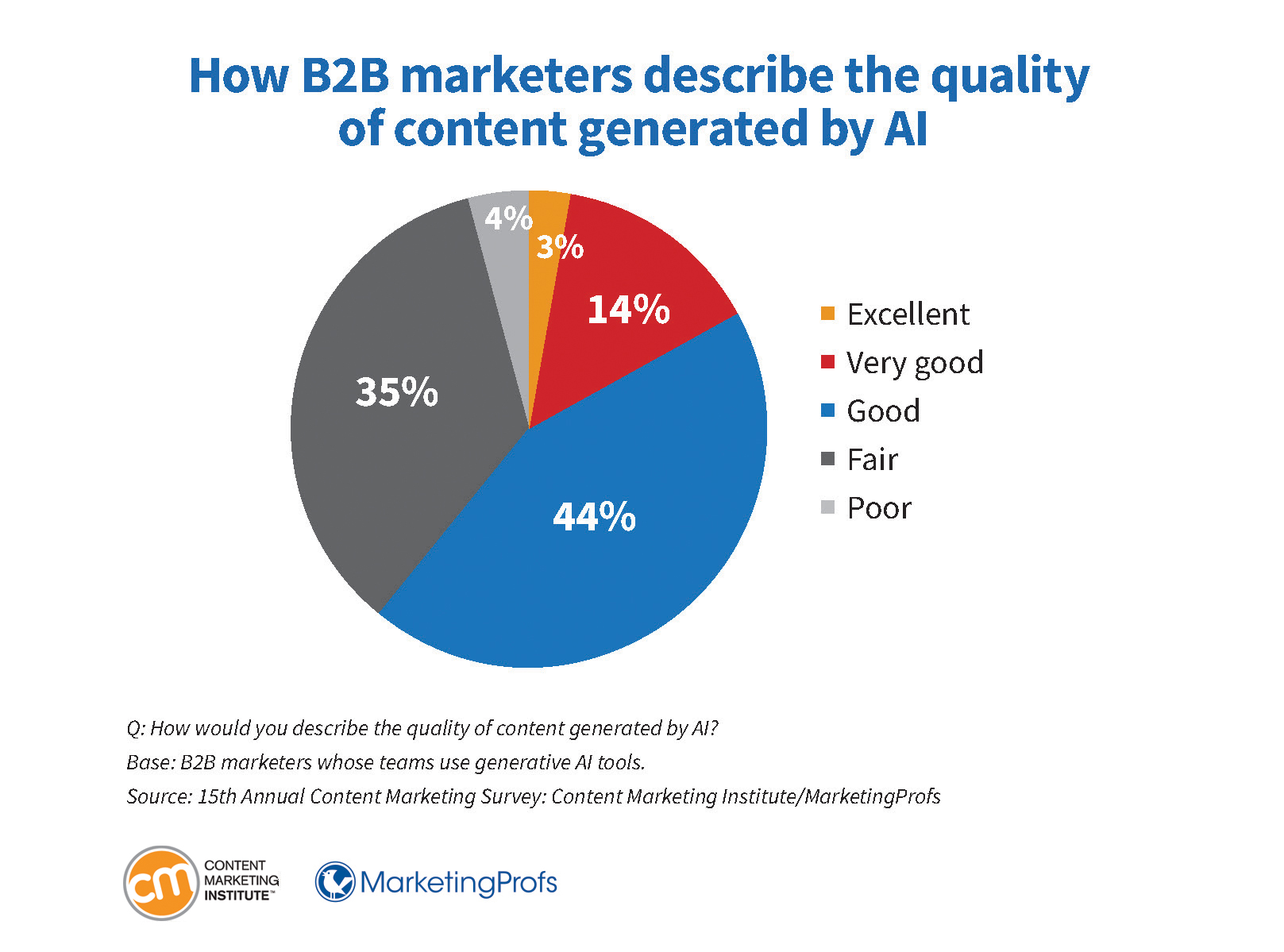
Content types, distribution, and social media
- Ninety-two percent of B2B marketers use short articles/posts, 76% use videos, and 75% use case studies/customer stories. B2B marketers say videos produce the best results for their content marketing.
- Most B2B marketers (89%) use organic social media platforms to distribute content. Eighty-four percent use blogs on corporate websites, 71% use email newsletters, and 63% use email. Fifty-five percent use both in-person events and webinars, which are the two distribution channels that B2B marketers say produce the best results for their content marketing.
- Eighty-five percent of B2B marketers say LinkedIn is the social media platform that delivers the best value for their organization.
- Eighty-four percent of B2B marketers use paid channels to distribute content. Among those, 73% use social media advertising/promoted posts, and 64% use search engine marketing (SEM)/pay-per-click (PPC), which marketers say is the most effective paid channel.
- Regarding their evolving use of social media platforms in the last 12 months:
- Sixty-eight percent of B2B marketers increased their use of LinkedIn, 27% stayed the same, 3% decreased, and 2% didn’t use it.
- Thirty-one percent increased their use of YouTube, 36% stayed the same, 10% decreased, and 23% didn’t use it.
- Twenty-seven percent increased their use of Instagram, 30% stayed the same, 11% decreased, and 32% didn’t use it.
- Twenty percent increased their use of Facebook, 40% stayed the same, 19% decreased, and 21% didn’t use it.
- Nine percent increased their use of TikTok, 7% stayed the same, 4% decreased, and 80% didn’t use it.
- Six percent increased their use of X, 27% stayed the same, 28% decreased, and 39% didn’t use it.
- Six percent increased their use of Reddit, 7% stayed the same, 2% decreased, and 85% didn’t use it.
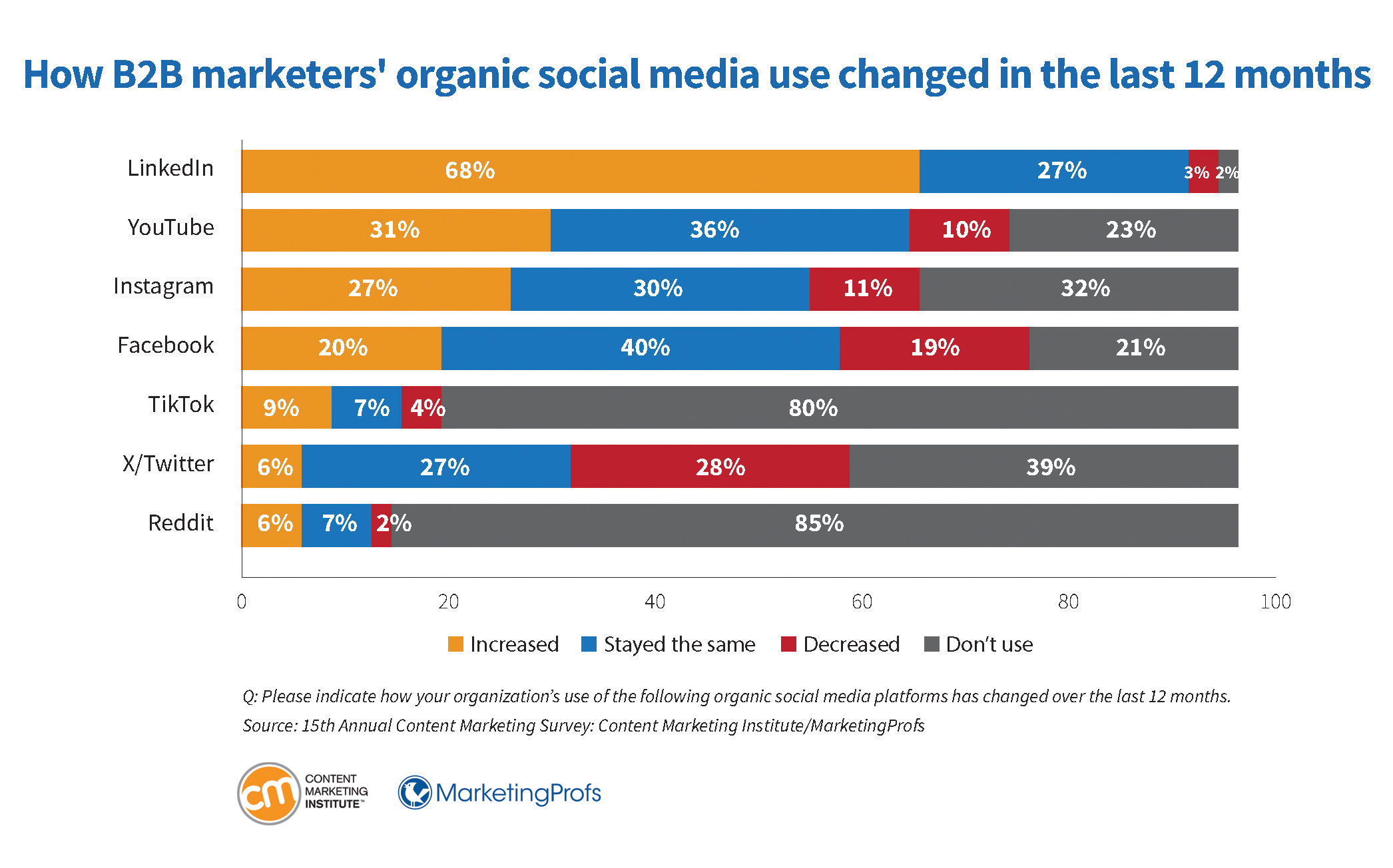
Content marketing budgets and investment for 2025
- Forty-six percent of B2B marketers think their content marketing budget will increase in 2025. Forty-one percent expect it to stay the same, 8% think it will decrease, and 5% are unsure.
- Most B2B marketers (61%) expect their organizations’ investment in video to increase in 2025. Fifty-two percent expect investment to increase in thought leadership content. Other areas of expected budget boosts include:
- AI for content optimization/performance (40%)
- Paid advertising (40%)
- AI for content creation (39%)
- In-person events (35%)
- Webinars (32%)
- Building online community (27%)
- Digital events (21%)
- Audio content (20%)
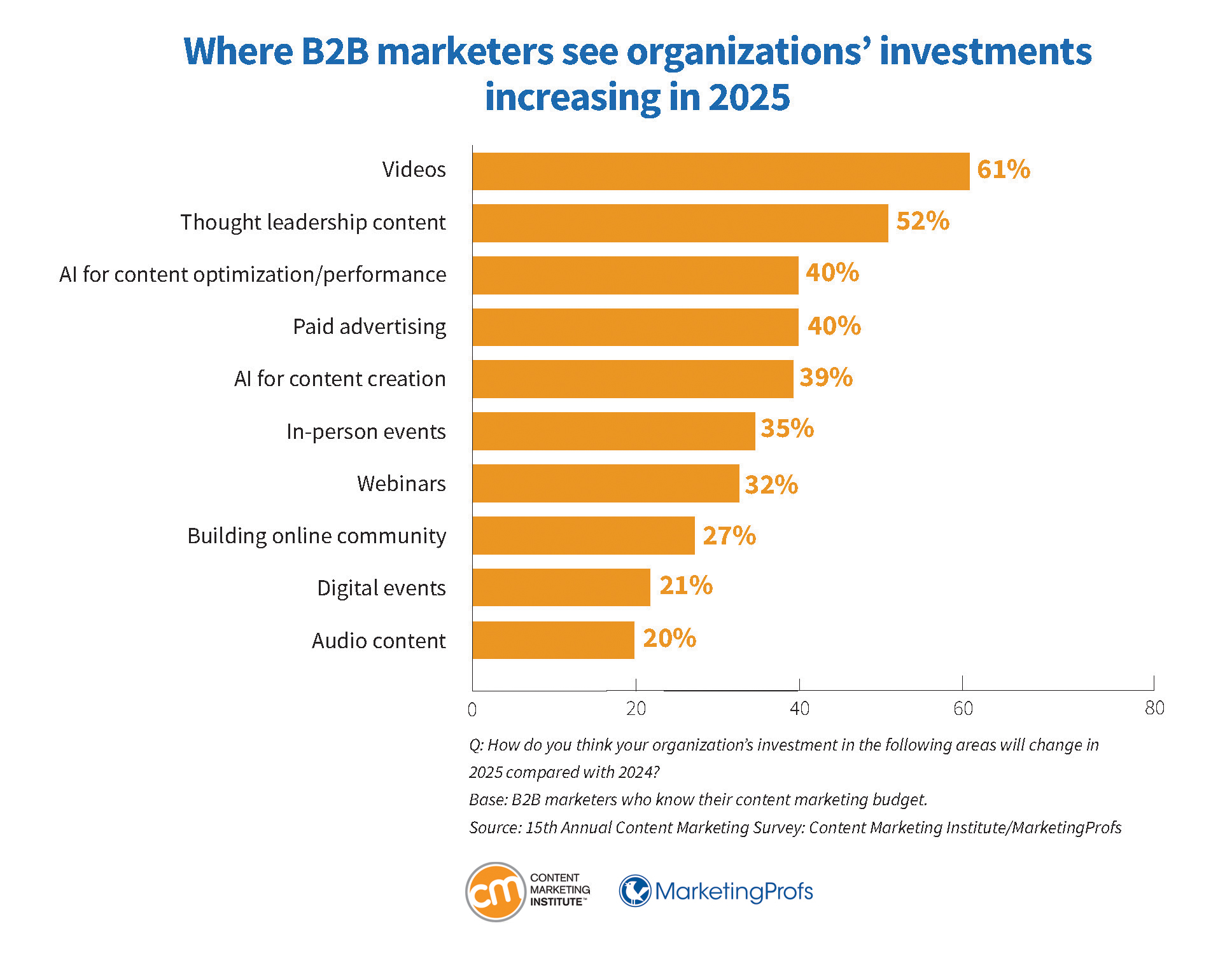
How to apply these stats to your content strategy
If, like many other B2B marketers, you feel meh about your content strategy, reflect on the past year, identify the problem areas, and plan for changes to make in 2025.

Chief Strategy Advisor
Content Marketing Institute
Here’s some advice from Robert Rose, CMI’s chief strategy advisor:
- Get your content house in order. Tackle the difficult work of creating cross-team governance, workflows, and standards.
- Regarding AI, come together to collaborate and commit to a few structured activities. An ad hoc approach won’t get you far.
- Stop doing activities that don’t contribute to targeted outcomes and quit measuring what doesn’t align with overall objectives.
Demand generation statistics for 2025
CMI’s Content Marketing for Demand Generation research explores the daily issues faced by demand generation marketers. Fifty-seven percent thought AI was the demand-generation trend/development that would have the biggest impact on their strategy in 2024.
Pressure to achieve results
- Over half of demand-gen marketers (56%) say they felt pressure to a great extent to achieve results despite limited budgets and resources. Another 39% felt that pressure to some extent, and only 5% felt no pressure.
- Almost one in four (24%) say their organization’s demand-generation strategies are extremely or very successful. Another 63% rate their programs as moderately successful. Ten percent say their strategies are not very successful, and 3% say they are not at all successful.
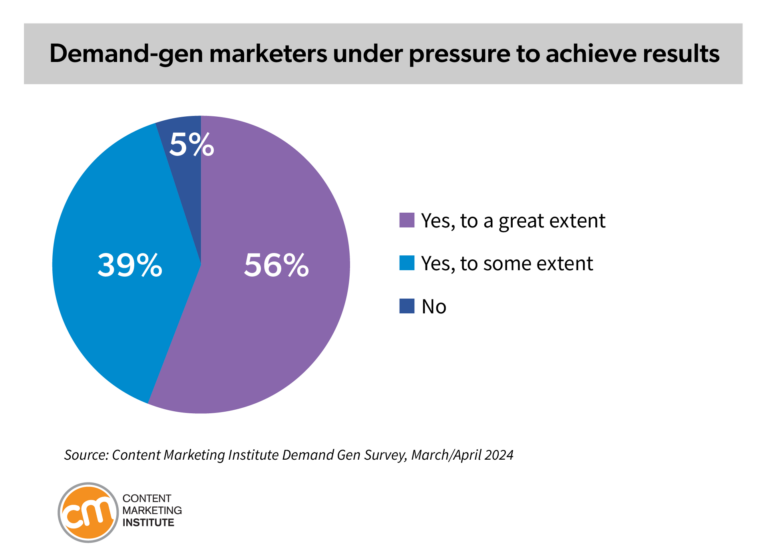
Ability to create targeted content
- Forty-seven percent rate their organizations’ ability to create targeted content as excellent or very good. More than half (53%) rate their ability as average, fair, or poor.
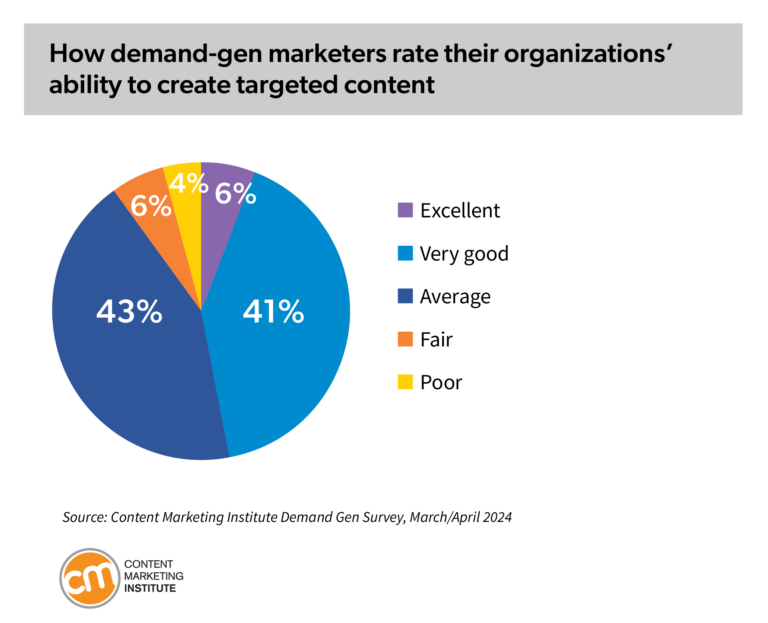
Budget allocation
- One in five demand-gen marketers spend more than half of their budget on demand generation; another 21% say it consumes more than a third of their budget. Email, in-person events, and video were the top three areas where they planned to increase spending in 2024.
Challenges faced
- Budget constraints are a challenge for 62% of demand-gen marketers. Fifty percent or more cite lack of internal resources (58%) and content issues (50%). Other challenges include:
- Audience segmentation (44%)
- Personalization (35%)
- Researching audiences to understand them better (31%)
- Identifying audiences (24%)
- Creating buyer personas (20%)
- Competition (18%)
- Lack of executive support (17%)
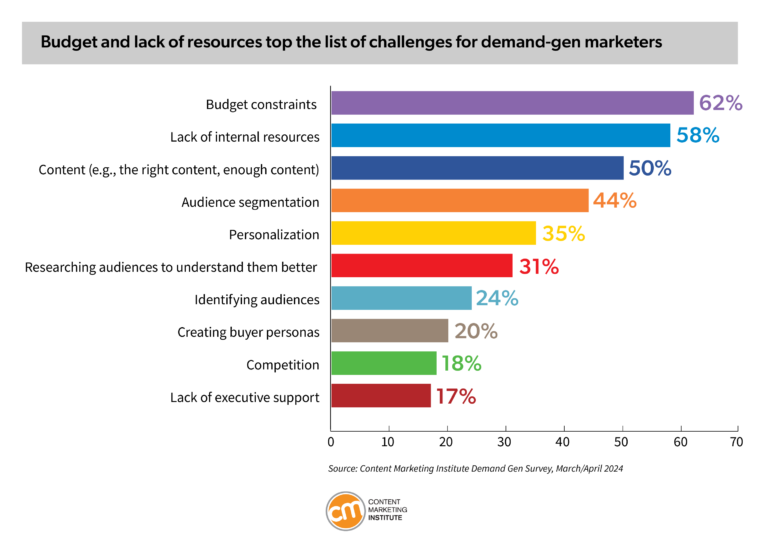
How to use these findings
If you feel pressured in your demand-generation efforts, face budget and resource issues, and worry you need to use AI to do more with less, you are not alone. It’s been a challenging year for marketers. CMI’s Robert Rose says, “Marketers who spend their efforts at the earliest parts of the customer journey have arguably had it the worst.”
Stay the course when it comes to creating targeted content. Know that AI cannot replace good ideas, a smart content strategy, and a solid measurement process.
Marketing to marketers research
In CMI’s first Marketing to Marketers study, we asked marketers about the content they value, how they learn about solutions, and why they choose the solutions they work with.
- Fifty-five percent of marketers prefer to consume work-related content by reading online. Twenty-six percent opt for videos, 11% prefer listening, and 8% choose print.
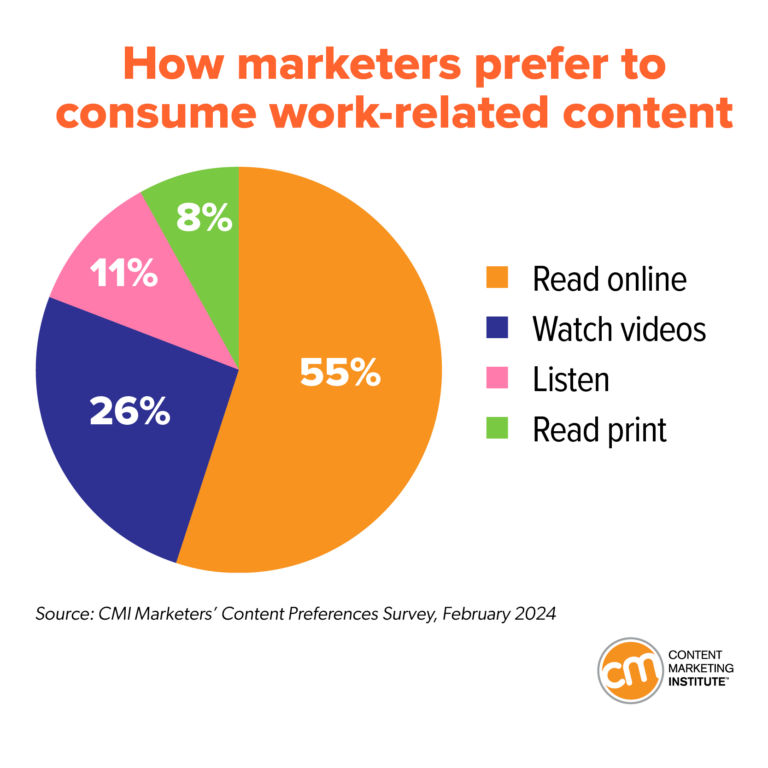
- The top five content types used by marketers researching tools, technologies, or services include:
- Online articles (94%)
- Videos (92%)
- Product reviews (81%)
- Case studies (75%)
- Webinars (72%)
- Forty-five percent of marketers prefer to discuss solutions on a video call. Twenty-seven percent want a text-based email, 7% choose a phone call, and 4% opt for an in-person meeting. Seventeen percent say they prefer no contact, perusing the vendor’s digital content on their own.
- Half of marketers (51%) attend one or two in-person events per year (either marketing-focused or specific to their industry).
- Almost all marketers (98%) attend digital webinars.
- Eighty-four percent of marketers who attend webinars say the most important thing they want is relevant and actionable content. Seventy-three percent say content that addresses current challenges and trends is important; 55% want on-demand access to recordings; 53% seek expert speakers with hands-on experience; 8% are looking for interactivity and engagement; and 8% say a user-friendly platform is important.
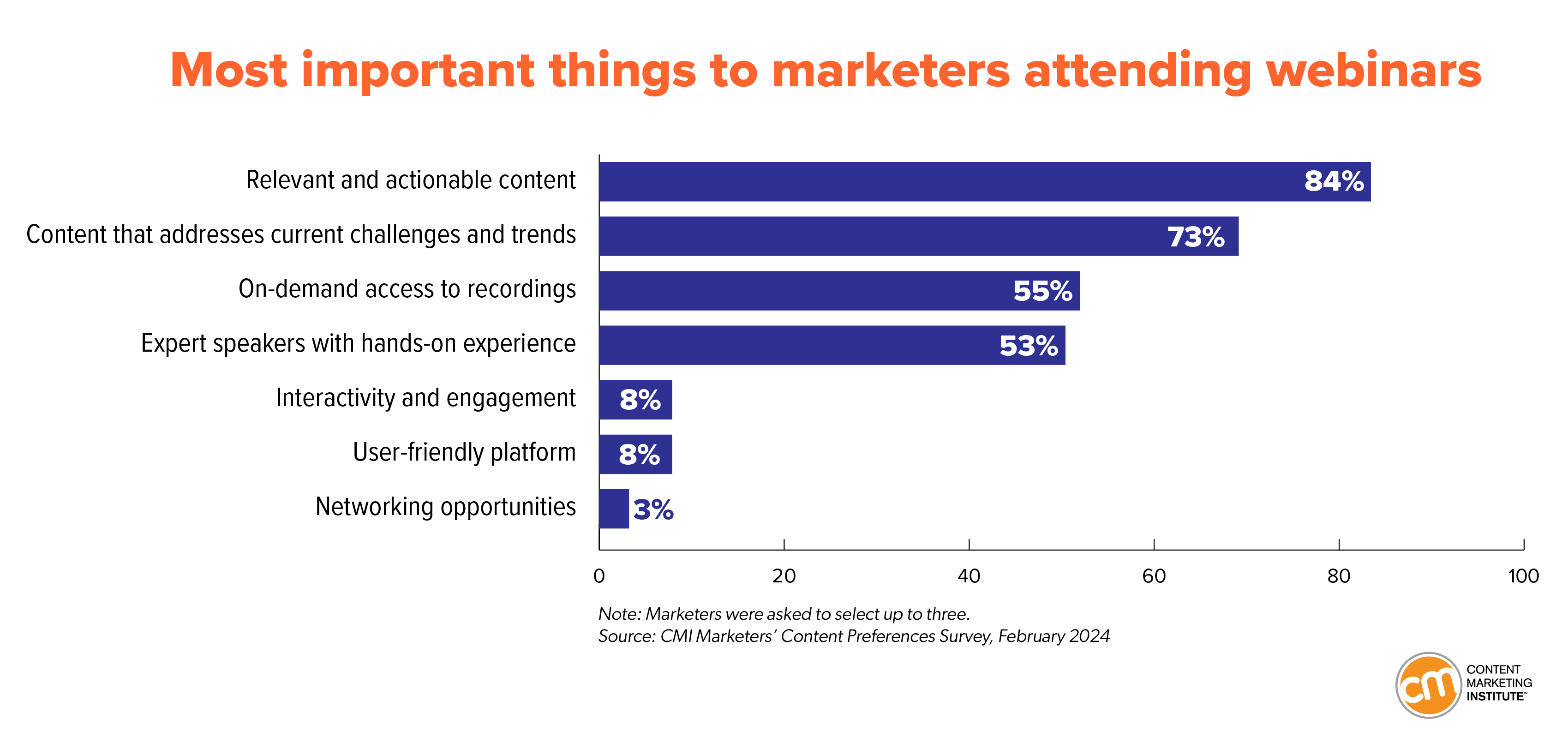
- Ninety-four percent of marketers say a company that makes extensive thought leadership content available raises their perception of the brand as a valuable information resource.
- Seventy-three percent of marketers say that their request for the content is the primary factor that prompts them to open an email. The second most compelling factor is a relevant subject line (62%).
How to use the findings
If you market to marketers, provide prescriptive, specific advice. Creating value requires a point of view and actionable content.
Marketers aren’t all that different from other business buyers. Yes, the bar may be higher because marketers know a pitch when they see one. Give them content that will inspire, educate, and engage. Otherwise, you’ll find your prospects avoiding sales conversations altogether.
Blogging in 2024
Andy Crestodina, co-founder and chief marketing officer of Orbit Media Studios, published the 11th Annual Blogger Survey in 2024. I’m including those findings because many of you are bloggers or involved with blogs and the findings are illuminating. Among the highlights:
- The average blog post is around 1,400 words and takes three hours and 48 minutes.
- Only 20% of bloggers report strong results, down from 30% five years ago.
- Those who spend more than six hours on each article are much more likely to report strong results.
- Bloggers who publish more often are more likely to report strong results. The data suggests that publishing content biweekly is the minimum for content performance.
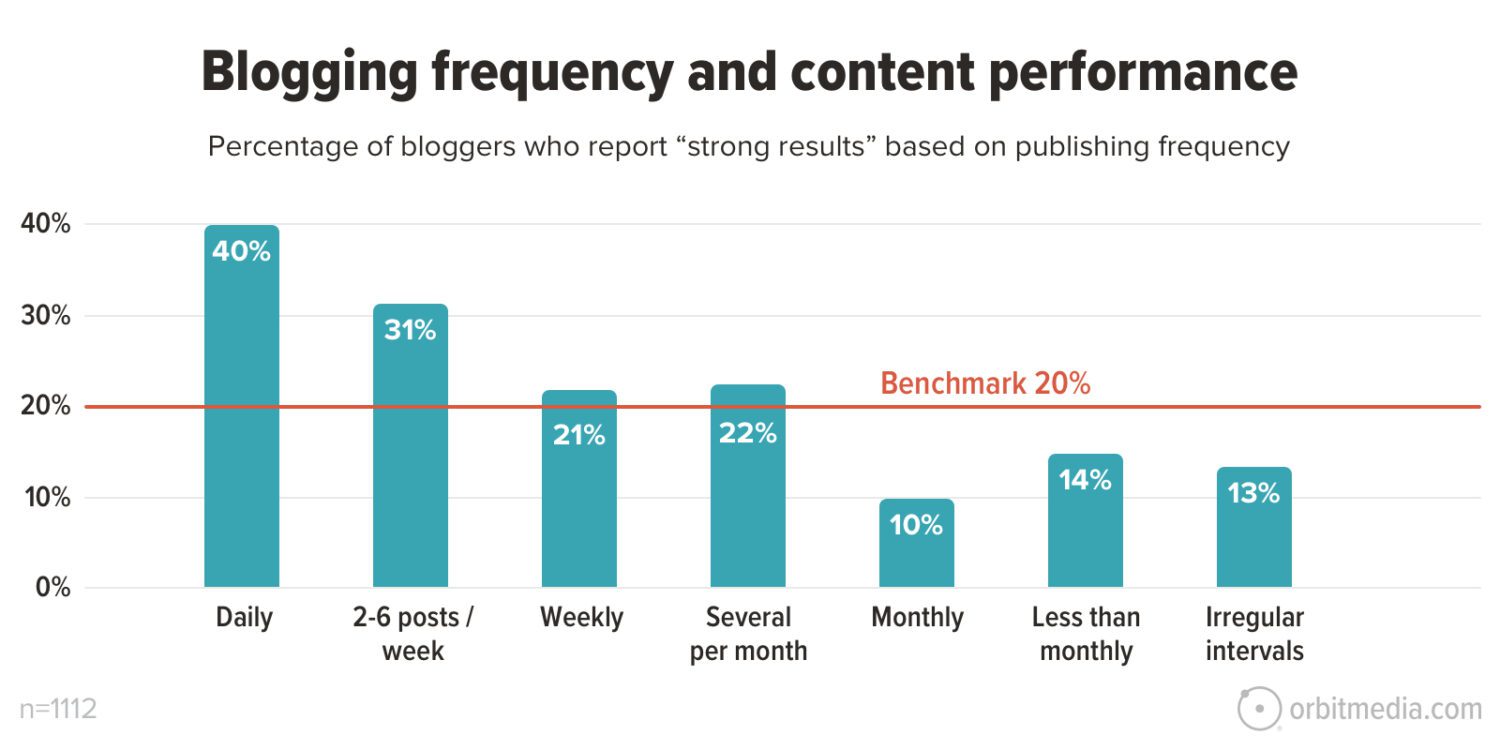
- Fifty-three percent say it’s gotten harder to attract visitors from search engines.
- Seventy-four percent of bloggers create how-to articles. Other structures include lists (50%), guides and e-books (46%), news and trends (45%), opinion (43%), original research (43%), interviews (34%), webinars (26%), infographics (22%), and roundups (22%). The most effective formats, according to bloggers who produce strong results, are roundups, infographics, and original research.
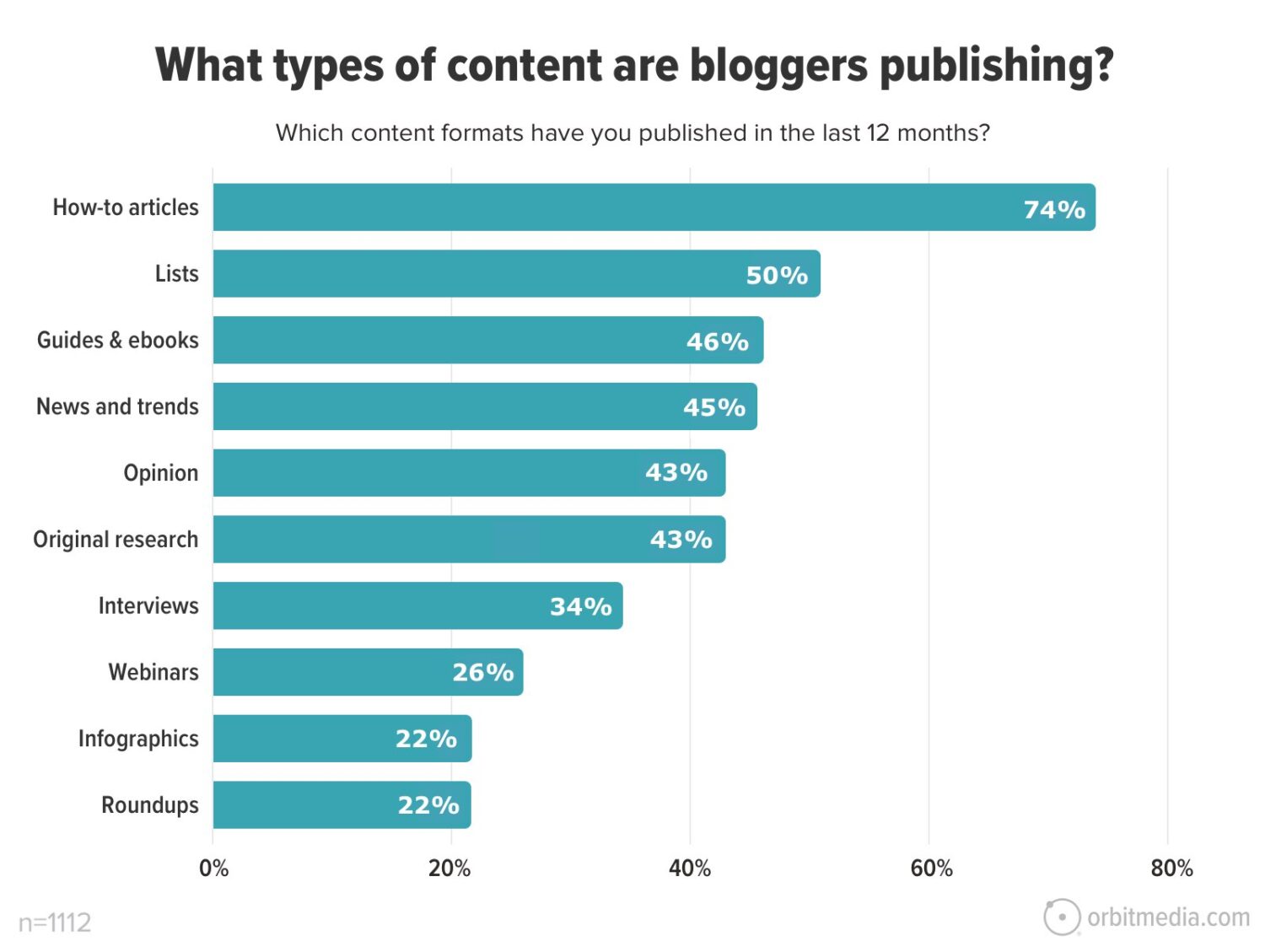
We asked Andy for some guidance on how to get better results from your publishing in 2025. Here’s what he suggests:

Co-founder & Chief Marketing Officer Orbit Media Studios
“Your content doesn’t just compete with competitors’ content. It competes for attention with the social streams themselves,” he says. “So, the more your content feels like a social stream, the more likely you are to keep your visitor engaged.
“What does this mean? Fill your content with visuals. Include lots of contributor quotes. Embed a few videos. Make it long and detailed. Inject a few strong opinions. That’s what the social platforms do. That’s why they are so compelling.”
How to use these stats
Use these findings to benchmark your blogging strategy against your peers. Questions to ask include:
- Are we spending the right amount of time writing blog posts?
- Are our blog posts the right length?
- Are we writing an ideal number of words in each post?
- Are we publishing often enough?
- Has it become harder for us to drive traffic to our blog via search? If so, how will we adapt?
- Are we publishing effective content formats?
Map out your strategy for a successful 2025
Stats are just figures, but they can help you tell the stories to make the case for the resources you need for a successful year. Use them to guide your thinking as you plan for 2025.
Finally, CMI would like to thank all the marketers who participated in our 2024 surveys. Your input helps advance the practice of content marketing, and we’re grateful.
Updated from a November 2023 article.
HANDPICKED RELATED CONTENT:
Cover image by Joseph Kalinowski/Content Marketing Institute
